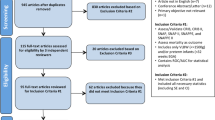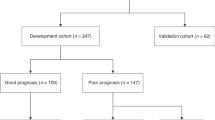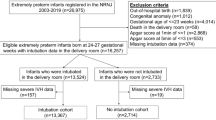Abstract
OBJECTIVE: To determine whether the Score for Neonatal Acute Physiology, Version II (SNAP-II), improved prediction of severe (≥grade III) intraventricular hemorrhage (IVH) and chronic lung disease (CLD) when compared to models using gestational age (GA) and traditional risk factors (e.g., Apgar score, small-for-gestational-age, sex, outborn status).
STUDY DESIGN: We examined 4226 infants ≤32 weeks' GA admitted to 17 Canadian neonatal intensive care units between 1996 and 1997. We compared prediction models for severe IVH and CLD, with and without SNAP-II.
RESULTS: SNAP-II was a significant and independent predictor of severe IVH and CLD. Addition of SNAP-II to models using GA and traditional risk variables significantly (p<0.05) improved model prediction (AUC 0.8 for severe IVH; 0.83 for CLD). Models were well calibrated (p>0.05 for Hosmer-Lemeshow goodness of fit test).
CONCLUSION: Addition of SNAP-II to models using GA and traditional risk factors significantly improves prediction of severe IVH and CLD.
This is a preview of subscription content, access via your institution
Access options
Subscribe to this journal
Receive 12 print issues and online access
$259.00 per year
only $21.58 per issue
Buy this article
- Purchase on Springer Link
- Instant access to full article PDF
Prices may be subject to local taxes which are calculated during checkout

Similar content being viewed by others
References
Kliegman RM . Neonatal technology, perinatal survival, social consequences, and the perinatal paradox Am J Public Health 1995 85: 909–13
Wennberg JE, Blowers L, Parker R, Gittelsohn AM . Changes in tonsillectomy rates associated with feedback and review Pediatrics 1977 59: 6 821–6
Richardson DK, Tarnow-Mordi WO, Lee SK . Risk adjustment for quality improvement Pediatrics 1999 103: 255–65
Gould JB . Vital records for quality improvement Pediatrics 1999 103: 278–90
Bard H . Assessing neonatal risk: CRIB vs. SNAP Lancet 1993 342: 449–50
Fowlie PW, Gould CR, Tarnow-Mordi WO, Strang D . Measurement properties of the clinical risk index for babies — reliability, validity beyond the first 12 hours, and responsiveness over 7 days Crit Care Med 1998 26: 163–8
Richardson DK, Corcoran JD, Escobar GJ, Lee SK . SNAP-II and SNAPPE-II: simplified newborn illness severity and mortality risk scores J Pediatr 2001 138: 92–100
Lee SK, McMillan D, Ohlsson A et al. Variations in practice and outcomes of the Canadian NICU Network 1996–7 Pediatrics 2000 106: 1070–9
Statistics Canada. Population [cited February 23, 2001] [six screens] Available from URL http://www.statcan.ca/english/Pgdb/People/population/demo.02.htm
Statistics Canada. Population [cited February 23, 2001] [six screens] Available from URL http://www.statcan.ca/english/Pgdb/People/population/demo.04.htm
Richardson DK, Gray JE, McCormick MC, Workman-Daniels K, Goldmann D . Score for Neonatal Acute Physiology (SNAP): a physiologic severity index for neonatal intensive care Pediatrics 1993 91: 617–23
Ballard JL, Novak KK, Driver M . A simplified assessment of fetal maturation of newly born infants J Pediatr 1979 95: 769–74
Whitfield M . British Columbia provincial growth charts B.C. Children's Hospital, 1992
Papile L-A, Burstein J, Burstein R, Koffler H . Incidence and evolution of subependymal and intraventricular hemorrhage: a study of infants with birth weights less than 1500 gm J Pediatr 1978 92: 529–34
Shennan AT, Dunn MS, Ohlsson A, Lennox K, Hoskins EM . Abnormal pulmonary outcomes in premature infants: prediction from oxygen requirement in the neonatal period Pediatrics 1988 82: 527–32
Richardson DK, Phibbs CS, Gray JE, McCormick MC, Workman-Daniels K, Goldmann DA . Birth weight and illness severity: independent predictors of neonatal mortality Pediatrics 1993 91: 969–75
Petridou E, Richardson DK, Dessypris N et al. Outcome prediction in Greek neonatal intensive care units using a Score for Neonatal Acute Physiology (SNAP) Pediatrics 1998 101: 1037–44
Escobar GJ, Fischer A, Li DK, Kremers R, Armstrong MA . Score for neonatal acute physiology: validation in three Keiser Permanente neonatal intensive care units Pediatrics 1995 96: 918–22
Hanley JA, McNeil BJ . The meaning and use of the area under a receiver operating characteristic (ROC) curve Radiology 1982 143: 29–36
Hanley JA, McNeil BJ . A method of comparing the areas under receiver operating characteristics curves derived from the same cases Radiology 1983 148: 839–43
Ruttimann UE . Statistical approaches to development and validation of predictive instruments Crit Care Clin 1994 10: 19–35
Lemonshow S, Le Gall JR . Modelling the severity of illness of ICU patients. A systems update JAMA, J Am Med Assoc 1994 272: 1049–55
Hosmer DW, Lemeshow S . Model-building strategies and methods for logistic regression Applied Logistic Regression. Chapter 4 New York, NY: John Wiley and Sons 1989 82–133
Hosmer DW, Hosmer T, le Cessie S, Lemeshow S . A comparison of goodness-of-fit tests for the logistic regression model Stat Med 1997 16: (9) 965–80
International Neonatal Network. The CRIB (Clinical Risk Index for Infants Score) score — a tool for assessing initial neonatal risk and comparing performance of neonatal intensive care units Lancet 1993 342: 193–8
Richardson DK, Tarnow-Mordi WO, Escobar GJ . Neonatal risk scoring systems: can they predict mortality and morbidity? Clin Perinatol 1998 25: 591–611
Pollack MM, Patel KM, Ruttimann U, Cuerdon T . Frequency of variable measurement in 16 pediatric intensive care units: influence on accuracy and potential for bias in severity of illness assessment Crit Care Med 1996 24: 74–7
Acknowledgements
The authors thank Douglas Richardson, MD, MBA, for his valuable advice in drafting the manuscript.
Author information
Authors and Affiliations
Consortia
Additional information
This study was supported by grants 40503 and 00152 from the Medical Research Council of Canada. Additional funding was provided by the B.C. Children's Hospital Foundation; Calgary Regional Health Authority; Division of Neonatology, Children's Hospital of Eastern Ontario; Child Health Program, Health Care of St. John's; The Neonatology Program, Hospital for Sick Children; Lawson Research Institute; Midland Walwyn Capital; Division of Neonatology, McMaster Health Sciences Centre; Mount Sinai Hospital; North York General Hospital Foundation; Saint Joseph's Health Centre; University of Western Ontario; Women's College Hospital.
Rights and permissions
About this article
Cite this article
Chien, LY., Whyte, R., Thiessen, P. et al. SNAP-II Predicts Severe Intraventricular Hemorrhage and Chronic Lung Disease in the Neonatal Intensive Care Unit. J Perinatol 22, 26–30 (2002). https://doi.org/10.1038/sj.jp.7210585
Published:
Issue Date:
DOI: https://doi.org/10.1038/sj.jp.7210585
This article is cited by
-
Early prediction of spontaneous Patent Ductus Arteriosus (PDA) closure and PDA-associated outcomes: a prospective cohort investigation
BMC Pediatrics (2019)
-
Early postnatal illness severity scores predict neurodevelopmental impairments at 10 years of age in children born extremely preterm
Journal of Perinatology (2017)
-
A risk prediction model for severe intraventricular hemorrhage in very low birth weight infants and the effect of prophylactic indomethacin
Journal of Perinatology (2014)
-
Addition of SNAP to perinatal risk factors improves the prediction of bronchopulmonary dysplasia or death in critically ill preterm infants
BMC Pediatrics (2013)
-
Clinical prediction models for bronchopulmonary dysplasia: a systematic review and external validation study
BMC Pediatrics (2013)



